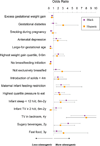Racial/ethnic differences in early-life risk factors for childhood obesity
- PMID: 20194284
- PMCID: PMC3836212
- DOI: 10.1542/peds.2009-2100
Racial/ethnic differences in early-life risk factors for childhood obesity
Abstract
Objective: By the preschool years, racial/ethnic disparities in obesity prevalence are already present. The objective of this study was to examine racial/ethnic differences in early-life risk factors for childhood obesity.
Methods: A total of 1343 white, 355 black, and 128 Hispanic mother-child pairs were studied in a prospective study. Mother's reported child's race/ethnicity. The main outcome measures were risk factors from the prenatal period through 4 years old that are known to be associated with child obesity.
Results: In multivariable models, compared with their white counterparts, black and Hispanic children exhibited a range of risk factors related to child obesity. In pregnancy, these included higher rates of maternal depression (odds ratio [OR]: 1.55 for black, 1.89 for Hispanic); in infancy more rapid weight gain (OR: 2.01 for black, 1.75 for Hispanic), more likely to introduce solid foods before 4 months of age (OR: 1.91 for black, 2.04 for Hispanic), and higher rates of maternal restrictive feeding practices (OR: 2.59 for black, 3.35 for Hispanic); and after 2 years old, more televisions in their bedrooms (OR: 7.65 for black, 7.99 for Hispanic), higher intake of sugar-sweetened beverages (OR: 4.11 for black, 2.48 for Hispanic), and higher intake of fast food (OR: 1.65 for black, 3.14 for Hispanic). Black and Hispanic children also had lower rates of exclusive breastfeeding and were less likely to sleep at least 12 hours/day in infancy.
Conclusions: Racial/ethnic differences in risk factors for obesity exist prenatally and in early childhood. Racial/ethnic disparities in childhood obesity may be determined by factors that operate at the earliest stages of life.
Conflict of interest statement
Figures

Similar articles
-
Reducing racial/ethnic disparities in childhood obesity: the role of early life risk factors.JAMA Pediatr. 2013 Aug 1;167(8):731-8. doi: 10.1001/jamapediatrics.2013.85. JAMA Pediatr. 2013. PMID: 23733179 Free PMC article.
-
Racial and Ethnic Disparities in Early Childhood Obesity.Pediatrics. 2018 Jan;141(1):e20170865. doi: 10.1542/peds.2017-0865. Pediatrics. 2018. PMID: 29269386 Free PMC article.
-
Lifecourse approach to racial/ethnic disparities in childhood obesity.Adv Nutr. 2012 Jan;3(1):73-82. doi: 10.3945/an.111.000919. Epub 2012 Jan 5. Adv Nutr. 2012. PMID: 22332105 Free PMC article. Review.
-
Prevalence of obesity among US preschool children in different racial and ethnic groups.Arch Pediatr Adolesc Med. 2009 Apr;163(4):344-8. doi: 10.1001/archpediatrics.2009.18. Arch Pediatr Adolesc Med. 2009. PMID: 19349563
-
Race, ethnicity and social class and the complex etiologies of asthma.Pharmacogenomics. 2008 Apr;9(4):453-62. doi: 10.2217/14622416.9.4.453. Pharmacogenomics. 2008. PMID: 18384258 Free PMC article. Review.
Cited by
-
Contextual and Parenting Factors Contribute to Shorter Sleep Among Hispanic/Latinx Compared to Non-Hispanic White Infants.Ann Behav Med. 2021 May 6;55(5):424-435. doi: 10.1093/abm/kaaa062. Ann Behav Med. 2021. PMID: 32914840 Free PMC article.
-
Association of cow's milk intake in early childhood with adiposity and cardiometabolic risk in early adolescence.Am J Clin Nutr. 2022 Aug 4;116(2):561-571. doi: 10.1093/ajcn/nqac103. Am J Clin Nutr. 2022. PMID: 35441227 Free PMC article. Clinical Trial.
-
Association between maternal postpartum depression and children's physical growth in early childhood: a birth cohort study.Front Pediatr. 2023 Jul 26;11:1135876. doi: 10.3389/fped.2023.1135876. eCollection 2023. Front Pediatr. 2023. PMID: 37565240 Free PMC article.
-
Kids in Action: the protocol of a Youth Participatory Action Research project to promote physical activity and dietary behaviour.BMJ Open. 2019 Mar 30;9(3):e025584. doi: 10.1136/bmjopen-2018-025584. BMJ Open. 2019. PMID: 30928943 Free PMC article.
-
Can ethnic background differences in children's body composition be explained by differences in energy balance-related behaviors? A mediation analysis within the energy-project.PLoS One. 2013 Aug 15;8(8):e71848. doi: 10.1371/journal.pone.0071848. eCollection 2013. PLoS One. 2013. PMID: 23967254 Free PMC article.
References
-
- Ogden CL, Carroll MD, Flegal KM. High body mass index for age among US children and adolescents, 2003–2006. JAMA. 2008;299(20):2401–2405. - PubMed
-
- Kuh D, Ben-Shlomo Y. A life course approach to chronic disease epidemiology: tracing the origins of ill-health from early to adult life. 2nd edition. London: Oxford University Press; 2004.
Publication types
MeSH terms
Grants and funding
LinkOut - more resources
Full Text Sources
Medical

